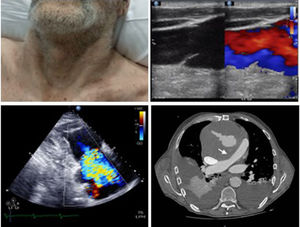A 74-years-old man with a history of ascendant aortic dissection repaired 5 years ago and two mayor episodes of intrathoracic infection needing long-term antibiotic treatment, came to the ER for a presternal tumor. CT scan detected a preaortic mass suggestive of an aortic pseudoaneurysm. Surgery was planned but cancelled for mild respiratory infection, acute renal and hepatic failure, needing ICU admittance. In the ICU, the patient at physical exploration neck engorgement and pulsatility stood up (video 1). Vascular and cardiac bedside ultrasound showed a reversed systolic flow in the jugular veins (video 2) and a severe triscuspid regurgitation (video 3) secondary to pulmonary hypertension due to extrinsic compression of the psedoaneurysm over the pulmonary artery (white arrow in Fig. 1). The patient rejected aggressive treatment and passed away 2 days later.
The Impact Factor measures the average number of citations received in a particular year by papers published in the journal during the two preceding years.
© Clarivate Analytics, Journal Citation Reports 2025
SRJ is a prestige metric based on the idea that not all citations are the same. SJR uses a similar algorithm as the Google page rank; it provides a quantitative and qualitative measure of the journal's impact.
See moreSNIP measures contextual citation impact by wighting citations based on the total number of citations in a subject field.
See more






